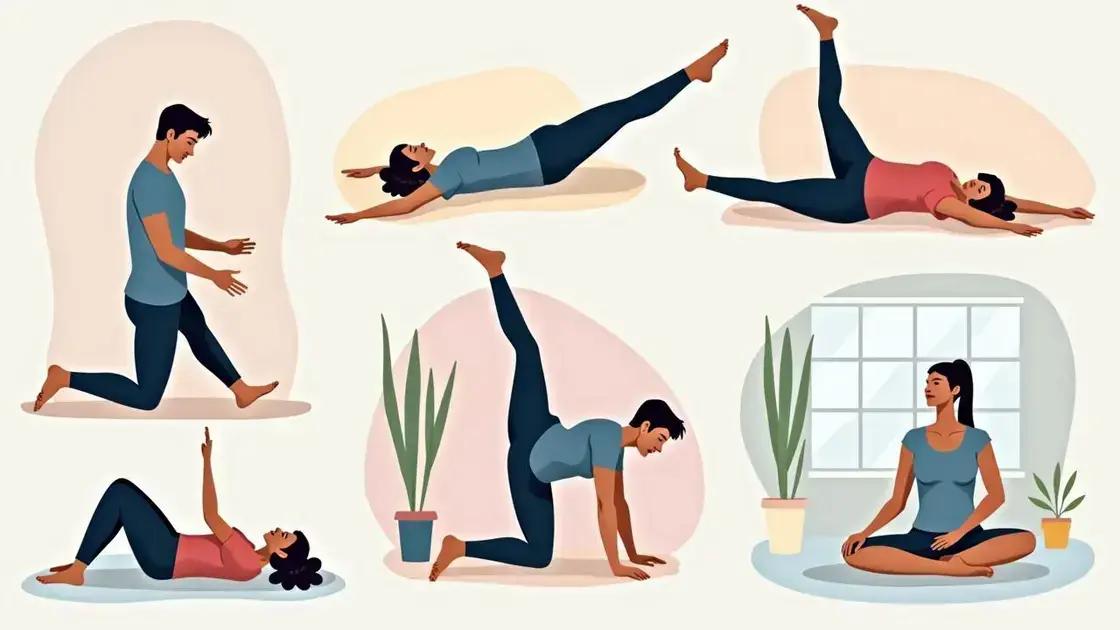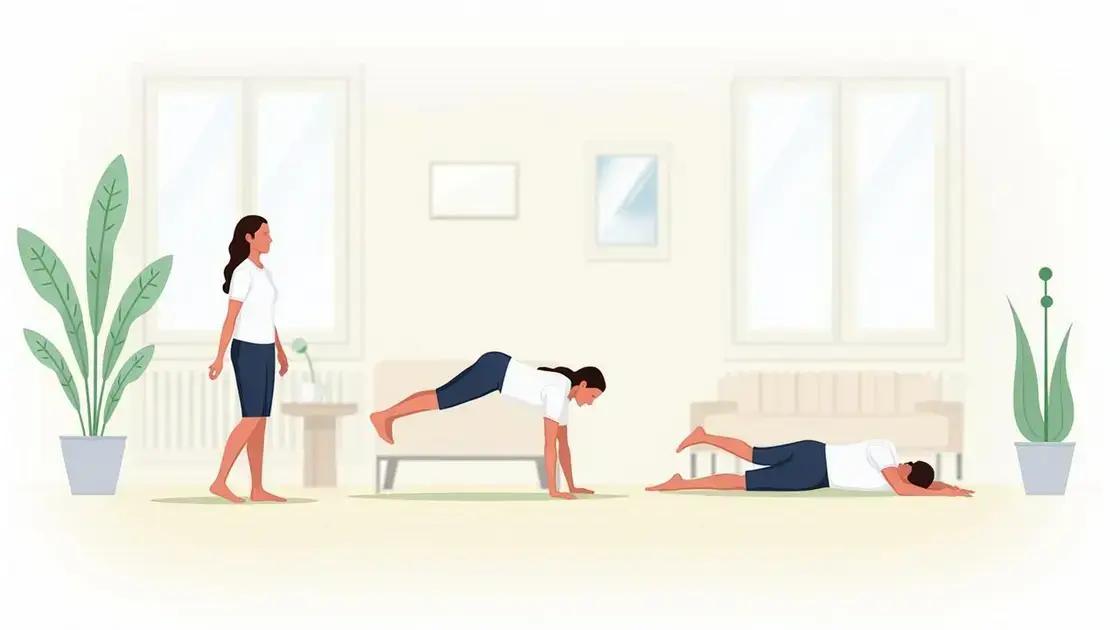Regular stretching can significantly relieve stiffness and improve flexibility. Incorporating effective stretching techniques into a consistent routine helps enhance mobility, reduce the risk of injuries, and promote overall physical well-being.
If you’re seeking ways to enhance your physical wellbeing, consider incorporating stretching into your daily routine. The benefits of regular stretching to relieve stiffness are profound, influencing not just flexibility but overall health. Stiffness can come from various causes, such as prolonged sitting or lack of physical activity, making it essential to address. In this post, we will explore understanding stiffness, the impact of stretching on flexibility, effective stretching techniques, and how to create a beneficial routine. Let’s dive into the transformative role stretching can play in your life and how it can lead to a more comfortable, active lifestyle.
Understanding Stiffness: Causes and Effects

Understanding Stiffness is essential for achieving a healthier and more flexible body. Stiffness can affect anyone, regardless of age or activity level. It often arises from various factors and can have significant consequences on our daily lives.
Causes of Stiffness
There are several primary causes of stiffness. One major reason is sedentary behavior, which includes sitting for long periods without movement. This can lead to tight muscles and reduced flexibility. Another cause is aging; as we get older, our muscles and joints may become less flexible.
Other Contributing Factors
Aside from age and inactivity, injuries can also lead to stiffness. When a muscle is injured, it often becomes tight to protect the affected area. Additionally, poor posture can contribute to stiffness, especially in the neck and back. Other factors like dehydration and muscle imbalances can further exacerbate the problem.
Effects of Stiffness
The effects of stiffness can limit your range of motion and lead to discomfort in daily activities. Stiffness can make it challenging to perform tasks like bending over to tie your shoes or reaching for something on a shelf. Moreover, chronic stiffness can increase the risk of injuries during exercise, as tight muscles are more prone to strains.
Understanding stiffness is crucial for recognizing how it affects your body. Identifying the causes and effects can help you take proactive steps, like incorporating stretching into your routine, to improve your overall health and flexibility.
How Stretching Improves Flexibility

Stretching is a vital practice that plays a significant role in increasing flexibility. By regularly stretching, you prepare your muscles and joints for better movement.
What Is Flexibility?
Flexibility refers to the ability of your muscles and joints to move through their full range of motion. Improved flexibility can enhance athletic performance, make everyday activities easier, and help reduce the risk of injuries.
How Stretching Works
When you stretch, it causes your muscles to lengthen and become more pliable. This lengthening effect can improve the elasticity of your muscles and tendons. As your muscles become more elastic, they can stretch further without injury. Moreover, stretching encourages better blood flow, which brings vital nutrients to your muscles.
Types of Stretching
There are different types of stretching, including static and dynamic stretching. Static stretching involves holding a stretch for 15-60 seconds, which helps to improve flexibility over time. Dynamic stretching includes movement-based stretches that prepare your body for activity.
Benefits of Improved Flexibility
Improved flexibility can lead to many benefits. It can enhance your overall athletic performance, reduce muscle soreness after workouts, and increase your range of motion. This makes it easier to perform daily tasks without discomfort.
By incorporating stretching into your routine, you can significantly improve your flexibility. Better flexibility not only feels good but also supports your fitness goals and general well-being.
Best Stretching Techniques for Relief

Incorporating stretching into your regular routine can provide effective relief from stiffness. Here are some of the best stretching techniques that can help.
1. Neck Stretch
This stretch can relieve tension in the neck. Sit or stand up straight. Slowly tilt your head to one side, bringing your ear toward your shoulder. Hold for 15-30 seconds and switch sides.
2. Shoulder Stretch
To perform a shoulder stretch, reach one arm across your body and hold it with the opposite arm. This stretch helps reduce tightness in the shoulders. Hold for 15-30 seconds and switch arms.
3. Cat-Cow Stretch
The Cat-Cow stretch is great for the spine. Start on your hands and knees. Inhale and arch your back, lifting your head and tailbone. Exhale and round your back, tucking your chin and pelvis. Repeat for 5-10 cycles.
4. Hamstring Stretch
To stretch your hamstrings, sit on the floor with one leg extended and the other leg bent. Reach toward your toes of the extended leg and hold for 15-30 seconds. Switch legs and repeat.
5. Quadriceps Stretch
Stand tall and grab one ankle, bringing it to your glutes. Keep your knees together and hold for 15-30 seconds. This stretch targets the front of your thighs.
6. Seated Forward Bend
Sit with your legs extended in front of you. Inhale and reach your arms overhead. Exhale as you hinge at the hips and lean forward, reaching for your feet. Hold for 15-30 seconds.
These stretching techniques can effectively alleviate stiffness and enhance your overall flexibility. Try incorporating them into your daily routine for the best results.
Creating a Stretching Routine for Daily Life

Creating a stretching routine for daily life is essential for relieving stiffness and enhancing flexibility. Here are steps to help you develop an effective routine.
1. Set a Schedule
Decide how often you want to stretch each week. A good goal is to stretch at least three to four times weekly. Pick a consistent time, such as in the morning or evening, to help make it a habit.
2. Start with a Warm-Up
Before stretching, it’s important to warm up your muscles. You can do a light 5-minute activity, like walking or marching in place, to get your blood flowing.
3. Choose Your Stretches
Select a variety of stretches targeting different muscle groups. Include stretches for your neck, shoulders, back, legs, and hips. This will ensure that you address stiffness in all areas of your body.
4. Hold Each Stretch
When you perform each stretch, hold it for about 15-30 seconds. Focus on breathing deeply and relaxing into the stretch. This allows your muscles to lengthen gradually.
5. Integrate Throughout the Day
You don’t have to limit stretching to a specific time. Consider incorporating stretches into your daily routine. For example, stretch while watching TV or take breaks during work to stand and stretch.
6. Listen to Your Body
Pay attention to how your body feels during stretching. Avoid pushing yourself too hard. If a stretch feels painful, ease up on the intensity. Stretching should feel good, not uncomfortable.
7. Stay Consistent
Building flexibility takes time, so consistency is key. Keep track of your stretching sessions and set goals to encourage regular practice. Celebrate small successes to stay motivated!
By creating a stretching routine and sticking with it, you can experience the amazing benefits of regular stretching, relieving stiffness and improving flexibility.
In Summary: The Importance of Regular Stretching
Incorporating regular stretching into your daily routine offers numerous benefits for relieving stiffness and enhancing flexibility. By understanding the causes of stiffness, recognizing how stretching improves flexibility, and utilizing effective stretching techniques, you can significantly improve your physical well-being.
Creating a consistent stretching routine allows you to integrate these practices into your everyday life, promoting better mobility and comfort. Remember, the key to effective stretching is to listen to your body, be consistent, and enjoy the process.
As you embrace these stretching benefits, you’ll likely find yourself feeling more energized, less tense, and better equipped to tackle daily activities.
FAQ – Frequently Asked Questions about Stretching and Flexibility
What are the benefits of regular stretching?
Regular stretching helps relieve stiffness, improves flexibility, enhances blood circulation, and reduces the risk of injuries.
How often should I stretch?
It’s recommended to stretch at least three to four times a week to achieve the best results in flexibility and stiffness relief.
What are some effective stretching techniques?
Effective stretching techniques include neck stretches, shoulder stretches, hamstring stretches, and the Cat-Cow stretch, among others.
How can I create a stretching routine?
Start by setting a schedule, choosing a variety of stretches, and holding each stretch for 15-30 seconds. Consistency is key!
Can stretching help with posture?
Yes, regular stretching can help improve posture by loosening tight muscles and promoting better alignment.
Should I stretch before or after exercising?
It’s beneficial to do dynamic stretching before exercising to warm up, and static stretching after your workout for relaxation and recovery.












